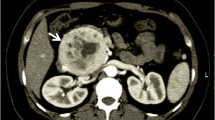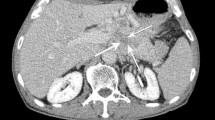Abstract
Aims
We aimed to present our series of gastrointestinal neuroendocrine tumours (GI-NETs) in order to illustrate and highlight the associated contrast-enhanced multi-detector computed tomography (MDCT) features. We also attempted to identify a relationship between MDCT imaging and the 2010 World Health Organization (WHO) classification system.
Materials and methods
We selected all patients with pathologically proven GI-NETs diagnosed between January 2010 and August 2017. Only patients undergone contrast-enhanced MDCT imaging in the immediate preoperative period were included in our study. Later, two expert radiologists retrospectively assessed MDCT intestinal and extra-intestinal signs. We also analysed the relationship between MDCT imaging and the 2010 WHO classification.
Results
A total of 20 patients (13 males, 7 females, age range 37–89 years, mean age 69.9 years) were included in our study. The majority of GI-NETs (85%) occurred in the small bowel and mainly in the terminal ileum. Forty-five percentage of our GI-NETs were diagnosed after an access to emergency medical service for obstruction symptoms or gastrointestinal bleeding. Regarding intestinal signs, 15/20 patients showed an intraluminal nodular mass and 5/20 a wall thickening. Extra-intestinal signs were present in 75% of cases. Desmoplastic reaction and lymph nodes metastases were significantly correlated with higher grade of GI-NETs.
Conclusions
The majority of GI-NETs appears as intraluminal mass often associated with extra-intestinal signs. We found a significantly correlation between higher grade of GI-NETs and extra-intestinal signs. MDCT imaging may be useful in predicting the pathological classification of GI-NETs.






Similar content being viewed by others

References
Klöppel G, Perren A, Heitz PU (2004) The gastroenteropancreatic neuroendocrine cell system and its tumors: the WHO classification. Ann N Y Acad Sci 1014:13–27
Tsai SD, Kawamoto S, Wolfgang CL, Hruban RH, Fishman EK (2015) Duodenal neuroendocrine tumors: retrospective evaluation of CT imaging features and pattern of metastatic disease on dual-phase MDCT with pathologic correlation. Abdom Imaging 40:1121–1130
Dahdaleh FS, Lorenzen A, Rajput M et al (2013) The value of preoperative imaging in small bowel neuroendocrine tumors. Ann Surg Oncol 20:1912–1917
Rockall AG, Reznek RH (2007) Imaging of neuroendocrine tumours (CT/MR/US). Best Pract Res Clin Endocrinol Metab 21:43–68
Ganeshan D, Bhosale P, Yang T, Kundra V (2013) Imaging features of carcinoid tumors of the gastrointestinal tract. AJR Am J Roentgenol 201:773–786
Klöppel G (2017) Neuroendocrine neoplasm: dichotomy, origin and classifications. Visc Med 33:324–330
Lloyd RV, Osamura RY, Klöppel G, Rosai J (2017) WHO classification of tumours of endocrine organs. IARC Press, Lyon
Klimstra DS (2016) Pathologic classification of neuroendocrine neoplasms. Hematol Oncol Clin N Am 30:1–19
Rindi G, Petrone G, Inzani F (2014) The 2010 WHO classification of digestive neuroendocrine neoplasms: a critical appraisal four years after its introduction. Endocr Pathol 25:186–192
Bosman FT, Carneiro F, Hruban RH, Theise ND (eds) (2010) WHO classification of tumours of the digestive system, vol 3, 4th edn. IARC Press, Lyon
Hristova L, Placé V, Nemeth J, Boudiaf M, Laurent V, Soyer P (2012) Small bowel tumors: spectrum of findings on 64-section CT enteroclysis with pathologic correlation. Clin Imaging 36:104–112
Sundin A, Arnold R, Baudin E et al (2017) ENETS consensus guidelines for the standards of care in neuroendocrine tumors: radiological, nuclear medicine and hybrid imaging. Neuroendocrinology 105:212–244
Tamm EP, Kim EE, Ng CS (2007) Imaging of neuroendocrine tumors. Hematol Oncol Clin N Am 21:409–432
Soyer P, Boudiaf M, Fishman EK et al (2011) Imaging of malignant neoplasms of the mesenteric small bowel: new trends and perspectives. Crit Rev Oncol Hematol 80:10–30
Taal BG, Visser O (2004) Epidemiology of neuroendocrine tumours. Neuroendocrinology 80(Suppl 1):3–7
Maggard MA, O’Connell JB, Ko CY (2004) Updated population-based review of carcinoid tumors. Ann Surg 240:117–122
Yao JC, Hassan M, Phan A et al (2008) One hundred years after “carcinoid”: epidemiology of and prognostic factors for neuroendocrine tumors in 35,825 cases in the United States. J Clin Oncol 26:3063–3072
Kaltsas GA, Besser GM, Grossman AB (2004) The diagnosis and medical management of advanced neuroendocrine tumors. Endocr Rev 25:458–511
Metz DC, Jensen RT (2008) Gastrointestinal neuroendocrine tumors: pancreatic endocrine tumors. Gastroenterology 135:1469–1492
Modlin IM, Kidd M, Latich I, Zikusoka MN, Shapiro MD (2005) Current status of gastrointestinal carcinoids. Gastroenterology 128:1717–1751
Oberg KE (2012) The management of neuroendocrine tumours: current and future medical therapy options. Clin Oncol (R Coll Radiol) 24:282–293
Dohan A, El Fattach H, Barat M et al (2016) Neuroendocrine tumors of the small bowel: evaluation with MR-enterography. Clin Imaging 40:541–547
Rindi G, Arnold R, Bosman F et al (2010) Nomenclature and classification of neuroendocrine neoplasms of the digestive system. In: Bosman F, Carneiro F, Hruban R, Theise N (eds) WHO classification of tumours of the digestive system. IARC Press, Lyon, pp 13–14
Zhu H, Ying L, Tang W, Yang X, Sun B (2017) Can MDCT or EUS features predict the histopathological grading scheme of pancreatic neuroendocrine neoplasms? Radiol Med 122:319–326
Author information
Authors and Affiliations
Corresponding author
Ethics declarations
Conflict of interest
The authors declare that they have no conflict of interest related to the publication of this article. No funding was received for this study.
Ethical approval
All procedures performed in the studies involvement human participants were in accordance with the ethical standards of the institutional and/or national research committee and with the 1964 Helsinki declaration and its later amendments or comparable ethical standards. Informed consent was obtained from all individual participants included in the study.
Rights and permissions
About this article
Cite this article
Grazzini, G., Danti, G., Cozzi, D. et al. Diagnostic imaging of gastrointestinal neuroendocrine tumours (GI-NETs): relationship between MDCT features and 2010 WHO classification. Radiol med 124, 94–102 (2019). https://doi.org/10.1007/s11547-018-0946-8
Received:
Accepted:
Published:
Issue Date:
DOI: https://doi.org/10.1007/s11547-018-0946-8



